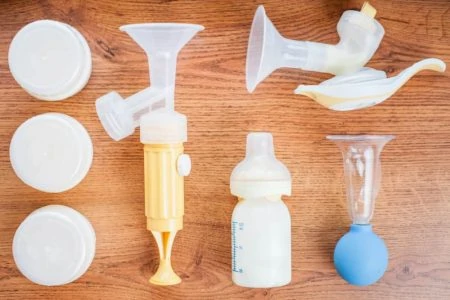Have you been watching hours pass as your newborn sits at your breast snacking? Does it always seem to happen at the same time each day? If so, your newborn may be cluster feeding.
As one of the challenges accompanying breastfeeding, cluster feeding confuses and frustrates many new parents. We understand because we’ve been there.
Although it’s a normal part of having a new little one around, cluster feeding can be exhausting and stressful for a new mom.
In this article, we’ll discuss how to recognize if your newborn is cluster feeding or if there are other issues at play. We’ll help you master the art of cluster feeding so you can turn it into a positive experience — for your whole family.
Key Takeaways
- Cluster feeding is a series of short, frequent feedings when a baby wants to feed every hour for a few hours.
- Common reasons for cluster feeding include growth spurts, slower milk flow, comfort-seeking, teething, and illness.
- Cluster feeding can be beneficial, helping babies sleep longer stretches and increasing milk production.
- To survive cluster feeding, make it part of your family routine, use the time to relax, create a family movie night, and time it around your spouse’s schedule.
What Is Cluster Feeding?
Cluster feeding is characterized as an intense series of short feedings — when your baby wants to feed every hour for a few hours. Newborns who cluster feed are also commonly extra grumpy during this period.
Breastfeeding can be exhausting, demanding, and confusing, but it is also gratifying in the long run. Try to remember that when the process gets tough.
Don't Doubt Yourself
Another important trait of a cluster-feeding baby is that outside of these feeding periods, babies can eat full amounts and go longer between eating. The cluster feedings are seen only during the same few hours.
Why Does Cluster Feeding Happen?
There are a few reasons babies will “snack” at the breast or a bottle. But cluster feeding typically happens in the evening because your baby is filling their belly and preparing to sleep for a longer period (1).
These are some other reasons your baby may be cluster feeding:
- Growth spurt: Sometimes, your baby needs extra calories to fuel their growth.
- Slower milk flow: Your milk production might have slowed down some, leading to extra feeding time and effort from your baby. Watch for any signs they aren’t getting enough milk.
- Desire for comfort: Babies can’t handle much, so if something upsets them, they need their mom in the most comforting way possible.
- Teething: Cluster feeding can help soothe the discomfort from teething.
- Illness: Babies may increase their feedings when they aren’t feeling well, such as when they’re fighting off an infection.
If the reason for the cluster feeding isn’t clear, check with your doctor.
Can Cluster Feeding Be Beneficial?
Many breastfeeding moms have mastered cluster feeding and have wielded it as a weapon against the “up every hour” nights that are so dreaded those first few months. When timed right and done correctly, cluster feeding can get you closer to a full night’s rest weeks before you ever thought it could be possible.
Cluster feeding shouldn’t be an all-day or an all-night activity. It should only take up around 4 hours of your time. This may still seem like a long time to be tied up breastfeeding, but it may lead to a longer stretch of sleep and improved feeding habits.
By changing the way you look at cluster feeding, you can start figuring out the best time to cluster feed and how to enjoy the benefits that follow.
Will It Change My Milk Supply?
Moms of cluster feeding and fussy babies often blame themselves and their breasts, chalking up this intense feeding to a lack of milk production on their end. In most cases, this isn’t true (2).
Cluster feeding can be nature’s way of ramping up milk production before a baby hits a growth spurt. Your baby’s frequent nursing can signal an increase in milk production to keep up with your growing baby’s needs (3).
As babies prepare to go longer stretches without food, you may notice your infant napping longer or sleeping for more than a couple of hours after cluster feeding. Sometimes the longer stretch of sleep happens first, but then your baby makes up for it by cluster feeding when they wake up.
The only time cluster feeding can signify your baby isn’t getting enough to eat is if they seem to be doing it all the time and are not producing enough wet diapers. If your baby is at the breast both day and night and never seems satisfied, it’s time to get some help.
Moving Night Cluster Feeding to Daytime
Babies are born with no sense of time, especially when it comes to night and day. Those differences mean nothing to your newborn, so if their cluster feeding time happens early in the day, they probably have their days and nights confused.
You can train your baby to reset their inner clock with these four easy steps.
1. Say No to Long Daytime Naps
If your baby goes down for a longer stretch of time at any point, it can be tempting to enjoy the peace for as long as it lasts. You may look at these long daytime naps as a way to get a nap of your own, a chance to catch up on housework, or finally make that call to your mom you’ve been putting off.
Unfortunately, when babies spend their daytime hours sleeping, they need all that extra food while it’s dark outside. And that makes for an exhausted mommy!
2. Gradually Reset Their Schedule
Once you’ve figured out that your baby isn’t cluster feeding at the right time and is struggling to get back on track, you can begin changing their feeding schedule little by little.
It’s impossible to expect a lot from a newborn when it comes to on-demand behaviors since their sense of time is so limited, but you can still do a few things to help them get a better sense of day and night. Move your feedings a little closer to when you want the cluster feeding to happen, and make adjustments as needed.
3. Keep Nighttime Activity to a Minimum
When your baby wakes up hungry in the middle of the night, feed them with as little disruption as possible. The key is to give them the milk they need while avoiding stimulation.
If you need to change their diaper, do so with minimal light and as little noise as possible. Keep your motions slow and soothing, and don’t rush the process. The more relaxed your baby is, the easier it will be for them to fall back to sleep.
Is Cluster Feeding a Red Flag?
On its own, cluster feeding is entirely natural and doesn’t indicate something else is going on with your baby.
Spending time worrying about your baby’s feeding habits is time wasted if they’re doing well in every other area. Check for wet and dirty diapers and weight gain. If you don’t see concerns there, then just relax!
If your baby never seems satisfied and seems permanently attached to the breast, it could be a warning sign. If you aren’t hearing or seeing your baby swallow, if your baby seems to be nibbling rather than sucking and swallowing, or if your baby is fussy much of the time, they may be using your breast as a pacifier and not really eating.
If you believe this is the case with your baby’s cluster feeding, work closely with your baby’s doctor and a lactation consultant to get their feeding back on track.
Editor's Note:
Michelle Roth, BA, IBCLC4 Tricks To Survive Cluster Feeding
Just because it has eventual benefits doesn’t make cluster feeding fun. I used to dread having to sit on the couch alone in silence and staring into space while my baby fed and fed and fed. I quickly learned I was doing it all wrong, and I’m here to share what I learned with you!
1. Make It Part of Your Family Routine
If your family has multiple children, sitting down for hours on end isn’t realistic. Try to make your cluster feeding sessions blend in with your family culture by including other family members.
Bring the party to your nursing chair, or feed your baby right at the dinner table. I even somehow managed to play board games while breastfeeding!
Once you make your newborn an attachment to your body and get used to the dynamic, you’re pretty much unstoppable!
2. Use This Time To Unwind and Relax
Remember that book you’ve meant to read for a year now? Or how about the show on Netflix you keep wanting to watch? Cluster feeding is a great time to get some time to yourself, well, as much as you can with a baby pressed against you.
Take this time to relax and reflect on yourself to reduce stress. I found that meditating during cluster feedings was a great way to unwind and let go of my nursing-related frustration.
3. Create a Family Movie Night
If you aren’t a fan of trying to multitask, get your spouse to turn on a movie you can enjoy together while nursing. You shouldn’t have to be isolated and alone if you don’t want to be, though it can be nice sometimes.
Don’t hesitate to be a little selfish during this time. A newborn can take a lot out of you, especially if you’re breastfeeding and dealing with unusual situations or poorly-timed cluster feedings. If you want to cuddle up and watch a timeless favorite, you should do so guilt-free!
4. Time It Around Your Spouse’s Schedule
For me, cluster feeding was hard because I’d been at home with my baby all day, and then it was time to breastfeed for hours right after my husband got home. He didn’t get to spend time with either of us! It was really difficult until I adjusted the feeding times.
I started by gradually pushing the feeding a little later to give myself about an hour and a half to spend with my husband before I needed to focus on feeding our little one. It worked out great, especially when I introduced activities the two of us could enjoy together while I nursed.












